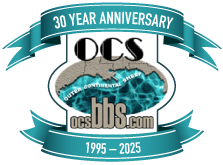Equipment Failure on Deepwater Rig While Running Casing in Open Waters
Effective Date: 5/3/2005
| U.S. Department of the Interior |
| Safety Alert No. 230 3 May 2005 | Contact: Glenn Woltman |
Equipment Failure on Deepwater Rig While Running Casing in Open Waters
During the deployment of the 22-inch surface casing in open water, an incident evolved resulting in the total loss of casing with inner cement stinger and wellhead. This incident occurred while the second stand of the 6-5/8 inch (drill pipe) landing string was being picked up, with the upper end of the first stand of drill pipe hanging in the rotary slips, and with the full weight of the entire string of 22-inch casing and subsea wellhead below. The slips suddenly jumped twice. The second jump apparently released the drill pipe from the slips and allowed the pipe with inner string to fall through the rotary.
Weather conditions at the time of the incident were reported to be benign. The acoustic doppler current profiler monitoring system was not functioning. Information on limiting current and wave environments versus the casing and landing string design criteria was not available. No stand-down conditions had been predetermined. Weight indicator information was not charted. Motion compensators on the rig were rendered unusable, since the pipe had been set in the slips. The length of the casing run exceeded the depth to the mudline, placing the end of the pipe below the low-pressure wellhead housing.
Key information needed to determine root cause(s) for the failure was not available. Conditions at the time of the incident may have been marginal to land the casing assembly successfully, given the sea state and the defined configuration of the drill pipe and casing assembly.
Material and procedural changes incorporating design margins made by the operator on the re-drill may have allowed the operations to proceed without incident. Listed below are the two significant operational changes made:
1. Shortening the 22-inch casing length (end of casing above 26-inch housing at the mudline), thus providing free end boundary conditions while running the inner string.
2. Changing the landing string for the 22-inch casing to a heavy wall drill pipe and using a set of slips with a longer contact length
to increase slip-crushing capacity.
The MMS recommends:
§ Operators working in open waters should consider stress analysis testing given defined configurations of the casing assembly at varying sea states, with a thorough analysis of all dynamic loads, including tripping loads and slip-crushing loads. Stand-down conditions should be identified and discussed during the JSA.
§ Operators should require continuous recording of hook loads on drilling rigs to capture data for trending analysis during all open water drilling operations.
§ Per MMS NTL 2005-G05, Operators will be required to measure loop currents to ensure all activities in open waters are in line with the safe operating envelope determined from previous stress analysis testing.
§ The slips and bowl should be inspected for wear in accordance with API Spec 8A.
§ Visual, dimensional, and flaw-detecting inspections should be performed on all handling tools, such as bails, slips, master bushings, elevators, spiders, and top drive stem assemblies, to verify load capacity. Elevators, spiders, and bails should be pull tested to the maximum anticipated load in accordance with API Spec 8B / ISO 13534:2000. Reference is made to API Spec 8C, Specification for Drilling and Production Hoisting Equipment (PSL 1 and PSL 2), third edition Addendum 1, and to ASTM E4-03, Standard Practices for Force Verification of Testing Machines.
A complete account of the accident is available on the MMS website at http://www.gomr.boemre.gov/homepg/offshore/safety/acc_repo/2005-027.pdf






